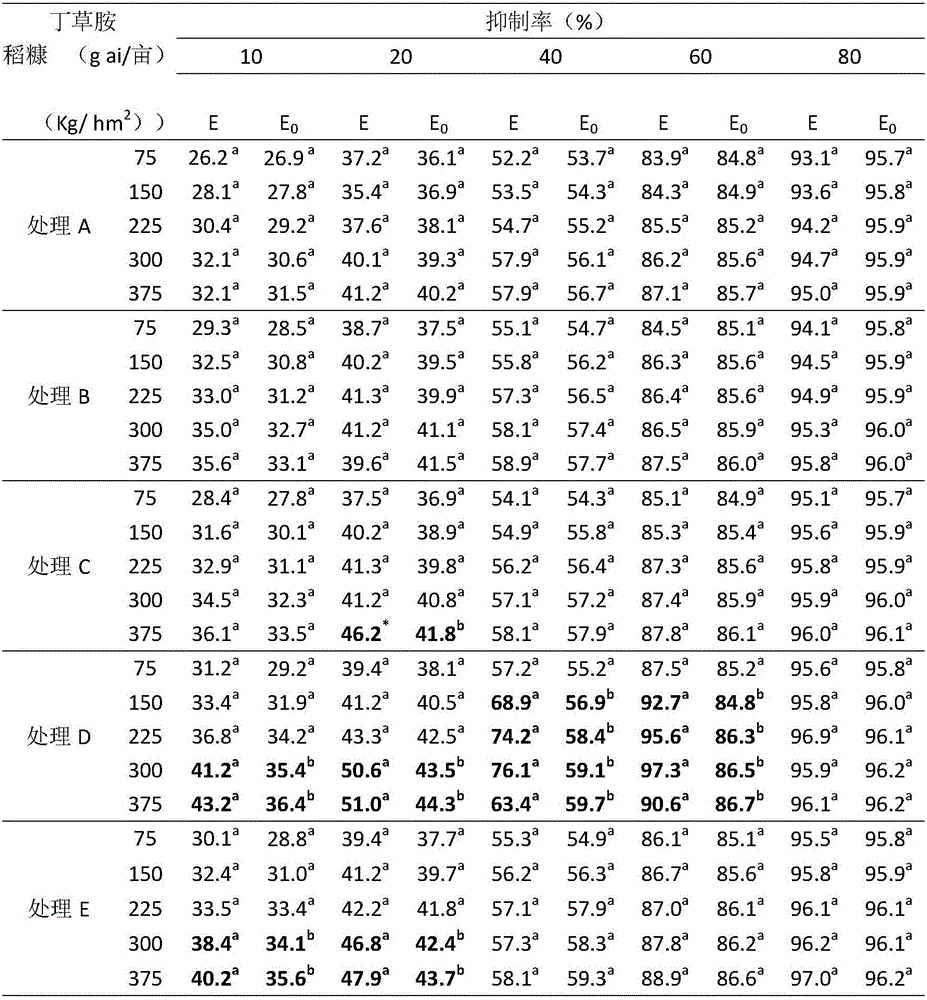Novel weeding composition for preventing and controlling weed in paddy fields and preparation method thereof
A herbicide composition and field weed technology, applied in botany equipment and methods, herbicides and algicides, biocides, etc., can solve the problems of unstable control effect, large amount of field use, and harm to human health. Achieve the effect of reducing the amount of field use, reducing the amount of field application, and the control effect is safe
- Summary
- Abstract
- Description
- Claims
- Application Information
AI Technical Summary
Problems solved by technology
Method used
Image
Examples
Embodiment 1
[0041] Evaluation of the ability of rice bran to suppress weeds in different rice varieties of Example 1
[0042] 1.1 Test materials
[0043] The rice bran materials used in the test included 4 categories of japonica rice, indica rice, hybrid rice and Yunnan local rice, a total of 30 species, and each material was specifically: japonica rice varieties (Yungeng 26, Yugeng 11, Yunjingyou 19, Yunjingyou 10 Yunjingyou 15, Yunguang 101, Chugeng 28, Yungeng 19, Chugeng 31, Yunguang 109, Yungeng 39, Fengdao 23); indica rice varieties (Yunguang 17, Yunliangyou 144, Yun You 948, Yunchao 7, Yiyou 673); hybrid rice varieties (Dianza 33, Dianza 31, Liangyou 1586, Dianza 35, Liangyou 2161, Liangyou 2111, Dianza 40, Dianza 37, Dianza Dianza 36, Dianza 41, Dianza 46, Yuza 33) and Yunnan local rice variety Xiaomagu. The above rice materials are common in production and have been planted for a long time. All rice materials were purchased from the seed market in Kunming.
[0044] 1.2 Test ...
Embodiment 2
[0053] The influence of embodiment 2 processing method on the grass-suppressing ability of xiaomagu rice bran
[0054] The study in Example 1 shows that the water extract of the rice bran of Yunnan local rice variety Xiaomagu has a significantly greater inhibitory effect on the growth of barnyardgrass than other varieties, and its 5% water extract has an inhibitory effect of 17.86% on barnyard grass under indoor conditions. Existing studies have shown that husk ketone contained in rice husk is the main effective component of rice husk to play the role of inhibiting weeds. However, rice husk is rich in cellulose, lignin, silica and other substances, which are difficult to degrade, and the husk ketone contained in it is also difficult to release, which affects the weed suppression effect of rice husk. In this study, different processing methods of rice bran were compared to explore their effects on the ability of rice husk to inhibit weeds.
[0055] 2.1 Test materials
[0056]...
Embodiment 3
[0074] Example 3 Study on the optimal ratio of rice bran to butachlor synergistic effect
[0075] Butachlor has a good control effect on monocotyledonous weeds in rice seedling fields, direct seeding fields, and transplanting fields. It is widely used in modern agriculture to control weeds in rice fields. However, the butachlor currently used in the market is emulsifiable concentrate, and its carrier is xylene and various other organic solvents. The impact of long-term and large-scale use of herbicides and various organic solvents on environmental pollution and food safety has aroused widespread concern. The research in Example 2 shows that the pulverized rice bran of rice xiaomagu is fermented with Bacillus subtilis, Bacillus licheniformis and lactic acid bacteria for 48-72 hours, then evaporated to dryness under reduced pressure and low temperature, and its weed-inhibiting ability to barnyard grass is significantly improved. This study envisages using the fermented product ...
PUM
 Login to View More
Login to View More Abstract
Description
Claims
Application Information
 Login to View More
Login to View More - R&D
- Intellectual Property
- Life Sciences
- Materials
- Tech Scout
- Unparalleled Data Quality
- Higher Quality Content
- 60% Fewer Hallucinations
Browse by: Latest US Patents, China's latest patents, Technical Efficacy Thesaurus, Application Domain, Technology Topic, Popular Technical Reports.
© 2025 PatSnap. All rights reserved.Legal|Privacy policy|Modern Slavery Act Transparency Statement|Sitemap|About US| Contact US: help@patsnap.com



